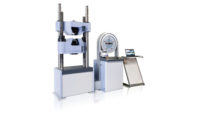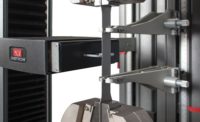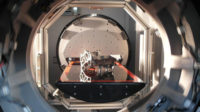Case Study
Materials Testing Supports Quality In Automotive Manufacturing
Supplier of testing solutions partners with leading auto makers to meet new challenges.

Volkswagen Group, which includes the Volkswagen, Audi, Porsche and Skoda brands, is projected to become the world’s largest auto manufacturer by 2018. The Volkswagen manufacturing plant in Chattanooga, Tennessee focuses on production of the brand’s Passat model and utilizes material testing as part of its approach to managing quality. Source: ©Volkswagen

The Allround-Line system from Zwick is utilized by auto manufacturers to validate mechanical performance of both materials and components. Source: Zwick

Components within novel drive train mechanisms require vigorous testing to address quality and cost reduction requirements and to maintain adherence to international standards. Source: ©Volkswagen

Safety initiatives motivate OEMs to engage in rigorous testing of components. This test system from Zwick enables manufacturers to simulate component performance in a low speed crash. Source: Zwick

Low speed crash simulations enable manufacturers to assess component performance, both as an input to the design cycle and as a means of controlling quality. Audi utilizes testing routines such as this to assess frame components that are precisely tuned to optimize for weight, cost or a combination of both. Source: Zwick





The global automobile industry is reaching record levels with the production of more than 80 million units in 2011 supported by more than EU 50 billion investment in research and development, according to BDW Automotive.
The drive to increase production—combined with aggressive quality, cost and performance goals—is being supported by a matrix of strategic alliances between the major OEMs and important parts, materials and equipment suppliers.
An example of this is the relationship between Zwick/Roell AG of Ulm, Germany, a supplier of materials and component testing solutions, and Volkswagen Group (VW) of Wolfsburg, Germany.
“We have been working closely with Volkswagen since the 1960s,” said Aleksander Koprivc, Automotive Industry Manager for Zwick.
The global automotive market is among the most important targets for materials test equipment. Zwick continuously invests a major part of its R&D budget in research and development of materials and component test solutions for the automotive industry, he said.
Zwick solutions are often used to validate new technologies and materials. Major initiatives have been launched in the automotive industry to characterize materials ranging from composites to magnesium for body, chassis, and power train applications. The introduction of hybrid electric vehicles and other powertrain technologies has also fostered testing routines that are aimed at validating the safety of batteries and the functionality of novel sensors.
“We are finding that automotive manufacturers are examining quality from several different perspectives. There are classical quality management initiatives that focus on qualification of new materials and components, as well as an emerging emphasis on the validation of components from new suppliers. As major initiatives such as ‘lightweighting’ continue to expand, we expect to see manufacturers increase their emphasis on component validation. Testing plays a major role in this area,” Koprivc said.
Forecasted to become the world’s largest auto manufacturer by 2018, VW Group is focused on growth through targeted car models, locally sourced and locally produced.
According to Charlie Lin, Quality Laboratory manager at Volkswagen’s Chattanooga, Tennessee manufacturing plant, testing for quality assurance, safety and performance are key to the strategy. The quality laboratory tests both the visible and unseen aspects of the vehicle, he said.
“The biggest challenge is proving the quality of a part that is also demonstrated to be the most cost effective,” Lin said.
The quality of the vehicle is the culmination of each department’s consistent focus in their respective fields. With a passion for detail, the Quality Laboratory ensures part quality with a thorough physical inspection based on VW’s technical specifications, he said.
VW is driving significant economies of scale through a unique manufacturing strategy known as MQB or modular transversal toolkit.
The toolkit approach provides flexibility in length, height and width to allow for more models to be produced, including regional variations, using a combination of both unique and variable parts. The strategy reduces unit cost, engineering hours per vehicle and supports the trends of significant reductions in weight, fuel consumption and emissions.
Zwick has partnered with VW Group in the development of materials test and quality assurance solutions that support the MQB concept, Koprivc said.
The VW Group, including the Audi, Porsche and Skoda brands, is currently employing a large volume of Zwick test equipment in its almost 100 production plants located on five continents, he said.
Materials testing is a key component of the MQB strategy, which involves the selection of very specific materials with specific mechanical properties for a variety of unique applications, he said.
The new Audi A3, for example, uses four grades of steel combined with aluminum to create the body, frame and chassis. Multi-material frames with variable wall thickness allow precise component tuning - optimizing for weight, cost or a combination of both.
“The emerging trend is toward fewer platforms but a much larger variation of bodies, enabling manufacturers to offer more models in each market,” Koprivc said.
New types of steel and aluminum alloys, some combined with polymers or fiber composites, are good examples of the type of materials being used to achieve goals including weight reduction and lower cost per unit, he said.
Volkswagen has some of the most stringent materials and component specifications in the entire automotive industry regarding vehicle components, Lin confirmed.
“With the data that we can obtain using our Zwick testing systems, we are able to be decisive on product quality. The part either passes of fails to meet VW specifications,” Lin said.
Also of importance is the establishment of an understanding as to why test results generated at one facility may deviate from those produced at other facilities worldwide. Additionally, as new components are designed into production that utilize new materials or new production processes, OEMs deploy testing routines that are aimed at determining why values may differ from those provided by a supplier.
“Zwick is increasingly lending support to the interpretation of results between different testing laboratories and between OEM and supplier. Global standardization is a trend that has surfaced and we have invested in the development of unique software capabilities that allow manufacturers to standardize testing procedures and methods on a global scale,” Koprivc said.
Initiatives aimed at reducing emissions and fuel consumption have generated several alternative power-trains such as those based on electric, hybrid and fuel cell technologies. Each of these new technologies is supported by new materials and specifications. Vehicles using some kind of electric drive system are projected to capture up to 20% of the overall production of new vehicles by 2020.
New components for the emerging electric car market, including lightweight battery packs and downsized drive train components, will require vigorous testing to meet quality and cost reduction goals as well as international standards.
A Lithium ion battery pack has at least seven component parts ranging from the case to the electronics and electro-mechanical components, which require testing to assure that requirements for weight, cost, durability and particularly safety are achieved.
In addition to a variety of electrical, thermal and performance tests, the requirements for mechanical tests of battery cells includes testing for impact, shocks, bending, crushing, penetration and stacking capacity of cells, Koprivc said. Connectors, cables, casings, wires, springs and circuit boards must also be tested to validate adherence to rigorous safety requirements.
Being able to accurately capture data under real world conditions is necessary to ensure parts meet performance and quality requirements, Koprivc stated.
As auto makers respond to greater demands for fuel efficiency, their internal test labs continue to experience increased demand for part qualification. Test throughput levels are emphasized to enable timely responses to manufacturing and design teams alike. As test labs seek new means to optimize test throughput, changeover time between tests must be minimized.
Addressing rising requirements for platform flexibility, the Zwick Z010 Allround-Line system is capable of measuring steering wheel adjustment mechanisms on three different testing axes for three different test profiles. The same platform may also be configured to test clutch operating forces. In this application, the system uses pneumatic specimen grips and adjusts for different clutch dimensions.
“The ability to reconfigure equipment quickly and easily for multiple tests saves time and is critical on the manufacturing floor,” Koprivc said.
Generating qualitative results for tests such as tensile strength, impact strength and compression forces on actual vehicle parts and having the capability to replicate those same tests with a high degree of reproducibility is critical, said Volkswagen’s Lin.
“Without data, you only have an opinion, and without reproducible data you still only have an opinion. To demonstrate the quality of a part, we must verify certain parameters. We utilize simulations to mirror in-service conditions as well as consumer use,” Lin said.
While some tests are proprietary to specific automotive makers, many are based on international standards. A number of these standards are developed by the ASTM International Committee E28 on Mechanical Testing. The committee’s 11 subcommittees maintain more than 55 standards that address ductility and formability, indentation, hardness, impact and residual stress.
According to ASTM, E8/E8M, tension tests provide a valuable reference for suppliers to measure the strength and ductility of materials under uniaxial tensile stresses. The information is useful in material comparison, alloy development, quality control and design.
Another key automotive material consideration is spring-back, which occurs when a metal or alloy is cold worked. On release of the forming force, the material tends to partially return to its original shape. ASTM Committee E28 released the ASTM E2492 standard test method for evaluating spring-back. Developed with input from automotive industry stakeholders, the standard provides a test to evaluate metal spring-back behavior through simulation of a stretch-draw forming process.
Zwick works closely with standardization organizations to monitor and participate in standards development. The company also works with customers and material and component suppliers to develop specific standards.
“We are assisting suppliers in the fulfillment of demanding VW testing standards. There are about 50 different VW testing standards where our machines may be applied,” Koprivc said.
Zwick/Roell AG
Zwick USA
2125 Barrett Park Drive
Suite 107
Kennesaw, GA 30144
(770) 420-6555
Looking for a reprint of this article?
From high-res PDFs to custom plaques, order your copy today!










